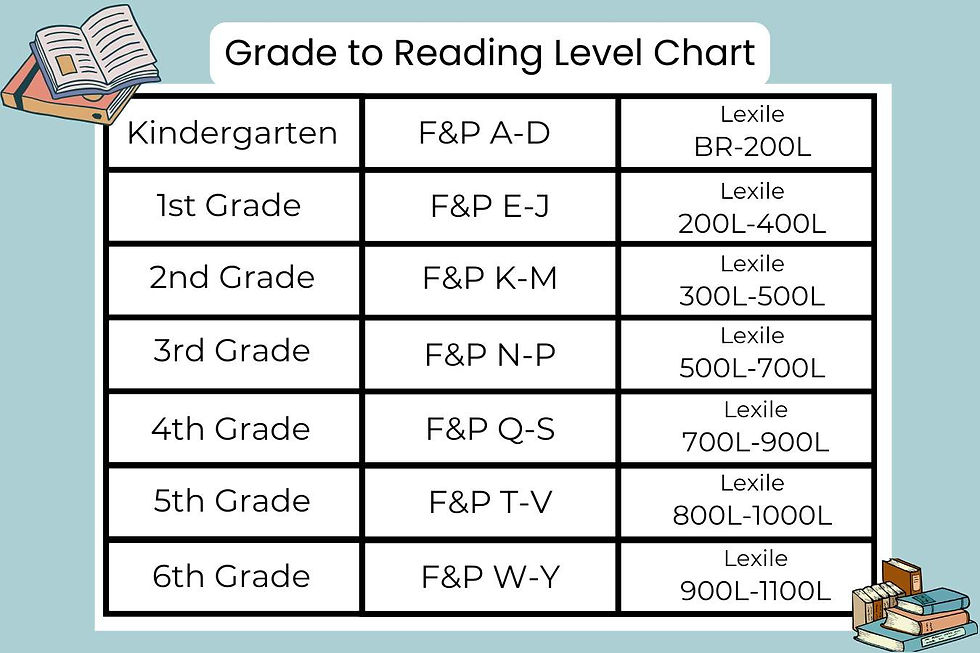Why Are There [so many] Reading Levels ... and How Do I Use Them?
- G. Shantz
- Dec 28, 2024
- 5 min read
If you're a parent, you've probably gotten reading level information from your child's school. It can be sent home on report cards, benchmark assessments, state testing results, and even book fair and book order handouts.
Or maybe you've been browsing at the library and read these different bits of reading level info that's often found on books - all geared to helping you pick something just right for your kid.
Let's break down what these scales mean and, most importantly, how they can help you support your child's reading journey.
What are Reading Level Scales For?
Think of reading level scales like different types of measuring tools—each one helps understand your child's reading in a slightly different way.

Schools use a variety of reading scales because each system serves different purposes. Here are some basics about common reading scales you might see:
Fountas & Pinnell (F&P): This is the one people often call "the reading levels with the letters." It measures reading ability using a gradient from A (easiest) to Z (most complex). It’s widely used to help match students with books that are right for their reading level.
Lexile Framework for Reading: This systems assigns a numerical score (e.g., 200L–1300L) to books and readers. For books, it measures text complexity (a combination of things like sentence length and word frequency). For readers, it measures reading ability by determining what level of text a reader is able to comprehend. Lexile is often used to track student progress and compare performance across grade levels, rather than from month-to-month.
Developmental Reading Assessment (DRA): Focuses on how well students read and comprehend different kinds of books, assigning levels from 1 to 80. This is most often used by elementary schools with students in grade K-3 to evaluate a student's reading level and identify their instructional needs for targeted support.
Accelerated Reader (AR): Assigns a level based on how difficult a text is to read, and it links to quizzes that assess comprehension. It's often used in incentive-based reading programs in schools and can make reading feel like a fun game.
Schools usually choose the scale that lines up with their curriculum and instructional goals. For example, one district might use F&P because it pairs well with classroom libraries. Another district might use Lexile because it helps them stay aligned with state testing systems.
How Can I Make Sense of Reading Level Data?
These levels might look different on the surface but they're all keeping track of things. Reading levels are determined by looking at:
Decoding: How confidently your child tackles new words they haven't seen before.
Fluency: How smoothly your child reads—kind of like going from riding a bike with training wheels to zooming along confidently!
Comprehension: How well your child understands the story or information they're reading.
Why Do Schools Measure Reading Progress with Reading Levels?
Just like we measure height to see how much kids are growing, reading levels help us see how they're progressing as readers.
Teachers often use them to help their students:
Finding perfect-fit books: Like finding shoes that fit just right, teachers can match students with books that are challenging but not frustrating.
Offering specific help: Sometimes readers need a little extra support in specific areas—these tools help identify where.
Celebrating success: All growth is good growth, and there's nothing better than seeing how far a student has come.
As a parent, understanding these levels can help you:
Make book shopping fun: Use the levels as a guide when picking out books with your child.
Watch for growth: Focus on progress and celebrate every step forward!
Understand the bottom line: Growth is what matters most.
Levels are just helpful tools. The real joy comes from seeing your child grow as a reader.
Here are some ways to keep the focus on what really matters:
Make reading fun: Let your child explore books they love, even if they're not at their exact level. You don't always read at your hardest level of challenge, and kids shouldn't either.
Celebrate every victory: Did they finish their first chapter book? Try reading a new type of story? These moments are worth noticing!
Keep the conversation going: Talk with your child's teacher about progress and ways you can make reading more enjoyable at home.
Common Questions About Reading Levels
What reading level should my child be at? Reading levels typically progress through grades K-6 as follows:

However, every child develops at their own pace, and these ranges are guidelines, not requirements.
If you want to compare reading scales, here's how:
You can find reading level charts online that show you how the systems match up or help you see the levels of books. Here are some useful links:
Lexile Parent Resources: Handy tool that lets you look up the Lexile of any book.
BookSource's Printable Chart: Gives grade, guided reading, Lexile, DRA, and Reading Recovery levels all on one chart.
Scholastic Book Wizard: This is a tool for finding book levels.
What if my child is reading below their grade level?
If your child is reading below grade level, there's a lot you can do. Learning to read can take time.
Every child develops differently, and there are many small ways to support reading growth:
Read together daily
Choose high-interest books at their current level
Practice sight words through games
Work with their teacher to develop a support plan
Consider reading aloud more advanced books to maintain their interest in complex stories
Join local summer reading programs in at your library
How often should reading levels be assessed?
Most schools assess reading levels 3-4 times per year: at the beginning of the school year, mid-year, and end of year. Some schools add an additional assessment in late fall.
Regular monitoring helps teachers track progress and adjust instruction. However, informal assessments happen continuously through classroom observations and reading conferences.
What's the best way to choose books for my child?
Sometimes you don't have time to look up a reading level or you're already in the store when you see an interesting book. One quick "on the spot" strategy I like for testing if a book is a good fit is the "five-finger rule" :
Pick a book and open it to any full page (I usually flip to the middle). Ask them to start to read at the top. Every time they hit a word they don't know, hold up another finger.
By the end of the page, if you're holding up:
0-1 fingers: This book may be too easy (but that isn't always bad!)
2-3 fingers: This is likely a "just right" book
4-5 fingers: This book may be too challenging for reading alone (independent reading)
Reading things that are easier can help build fluency. Reading things that are more challenging can build skills. Kids get benefits from all kinds of reading!
Helpful Links for Parents
Reading Rockets: A lot of tips for helping young readers succeed.
Lexile Hub: A spot for finding books and understanding Lexile levels.
Scholastic's Parent Page: Bookseller that also offers helpful lists, info on reading levels, and free seasonal downloads.
Readworks' Parent Page: A nonprofit focused on giving every reader access to high-quality and engaging content. Creating an account is free.
Reading levels are just one helpful part of a child's reading education. They're a way for you to monitor progress, and they help when you are trying to choose a book.
The most important thing is to nurture your child's love of stories and learning. Every step forward is a good one - no matter which scale your school uses.
When you're ready, here's how I can help you:
Check out my free printables section.
If you want the relief and peace you get from an executive function coach, here's some info.
Let's talk about what you'd like help with.
To make sure you don't miss out on new stuff, consider subscribing! I don't write often. I'll never share your email.



